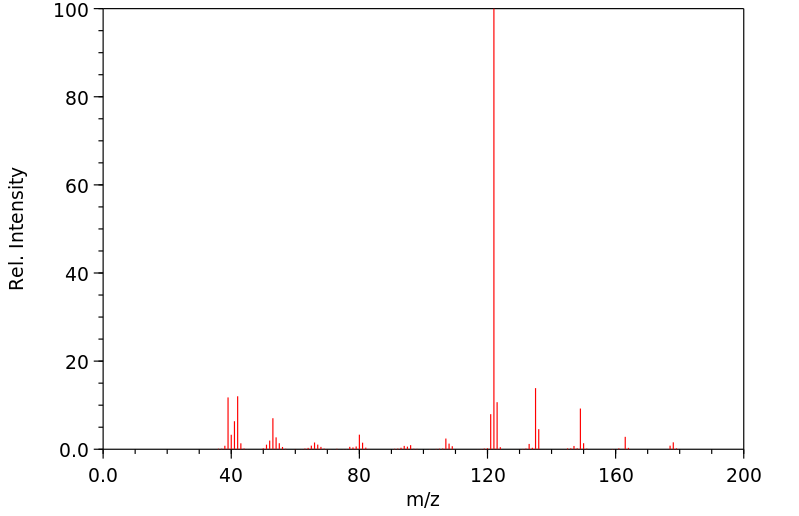2,5-二甲基-3-戊基-吡嗪 | 56617-69-7
中文名称
2,5-二甲基-3-戊基-吡嗪
中文别名
——
英文名称
2,5-dimethyl-3-pentylpyrazine
英文别名
——
CAS
56617-69-7
化学式
C11H18N2
mdl
——
分子量
178.277
InChiKey
VJNUCPVMBFFSSP-UHFFFAOYSA-N
BEILSTEIN
——
EINECS
——
-
物化性质
-
计算性质
-
ADMET
-
安全信息
-
SDS
-
制备方法与用途
-
上下游信息
-
文献信息
-
表征谱图
-
同类化合物
-
相关功能分类
-
相关结构分类
物化性质
-
保留指数:1291
计算性质
-
辛醇/水分配系数(LogP):2.8
-
重原子数:13
-
可旋转键数:4
-
环数:1.0
-
sp3杂化的碳原子比例:0.64
-
拓扑面积:25.8
-
氢给体数:0
-
氢受体数:2
反应信息
-
作为反应物:描述:参考文献:名称:Pyrazines. I. Pyrazine-N-oxides. Preparation and Spectral Characteristics1摘要:DOI:10.1021/ja01528a035
-
作为产物:描述:2,5-二甲基-3-[(1E)-1-戊烯-1-基]吡嗪 在 palladium on activated charcoal 氢气 作用下, 以 二氯甲烷 为溶剂, 23.0 ℃ 、303.97 kPa 条件下, 以100%的产率得到2,5-二甲基-3-戊基-吡嗪参考文献:名称:Zirconium-mediated reactions of alkylpyrazines and alkynes. Synthesis of highly substituted alkylpyrazines摘要:Sequential one-pot addition of alkylpyrazines, alkynes, and a proton source to a solution of Cp2Zr(Me)(THF)+ (1) in CH2Cl2 at room temperature affords (E)-alkenyl-substituted alkylpyrazines 2-10 in excellent yields. The regio- and stereoselectively observed in these reactions is similar to those observed previously for related early transition metal-mediated reactions and is ascribed to steric and Si electronic effects. Conventional synthetic organic manipulation of the alkenylpyrazines provides easy access to a variety of highly substituted alkylpyrazines including tri- and tetrasubstituted alkylpyrazines 13, 17-20, dibromoalkylpyrazine 14, bromoalkylpyrazine 15, and epoxyalkylpyrazine 16.DOI:10.1021/jo00048a038
文献信息
-
Preparation of pyrazines申请人:SOCIETE DES PRODUITS NESTLE S.A.公开号:EP1357193A1公开(公告)日:2003-10-29The present invention relates to a new process for the generation of pyrazines consisting in the bioconversion of hydroxyketones with 1,2-diaminopropane. New tetrahydropyrazine derivatives as well as new dihydropyrazine derivatives with high flavour and low threshold properties are disclosed. Such pyrazines compounds exhibiting roasted and earthy aroma profiles may be used in the food and bevererage industry, especially chocolate, confectionery and coffee.
-
Site-Selective C–H Alkylation of Diazine <i>N</i>-Oxides Enabled by Phosphonium Ylides作者:Prithwish Ghosh、Na Yeon Kwon、Sangil Han、Saegun Kim、Sang Hoon Han、Neeraj Kumar Mishra、Young Hoon Jung、Sang J. Chung、In Su KimDOI:10.1021/acs.orglett.9b02365日期:2019.8.16The synthesis of alkylated diazine derivatives is important for their practical utilization as pharmaceuticals and for other purposes. Herein, we describe the metal-free site-selective C–H alkylation of diazine N-oxides using phosphonium ylides that affords a variety of alkylated diazine derivatives with broad functional group tolerance. The utility of this method is showcased by the late-stage functionalization
-
Synthesis and pyrolysis of two flavor precursors of oct-1-en-3-yl methylpyrazinecarboxylates作者:Miao Lai、Xiaoming Ji、Tao Tao、Yuanyuan Shan、Pengfei Liu、Mingqin ZhaoDOI:10.1007/s10973-016-6083-5日期:2017.6To rich flavor additive species of pyrazines, two new compounds of 3,6-dimethyl-2,5-pyrazinedicarboxylic acid 1-octen-3-yl ester (DMPOE) and 3,5,6-trimethyl-2-pyrazinecarboxylic acid 1-octen-3-yl ester (TMPOE) were synthesized by KMnO4 oxidation, acylating chlorination and esterification reaction, in which tetramethylpyrazine and 1-octen-3-ol were used as initial materials. Thermogravimetry (TG), differential scanning calorimeter (DSC) and pyrolysis–gas chromatography/mass spectrometry (Py–GC/MS) were conducted to investigate the thermal degradation behaviors of DMPOE and TMPOE. TG–DTG results indicated that the T p of DMPOE and TMPOE with the largest mass loss rate was at 310 and 250 °C, respectively. The T peak of DMPOE and TMPOE showed by DSC curves was 301.8 and 260.0 °C, respectively. Py–GC/MS was performed to benefit the simulation of cigarette burning conditions, and the results indicated that DMPOE and TMPOE could release specific flavors of 1-octen-3-ol and diversified alkylpyrazines. Furthermore, the thermal degradation mechanisms of the flavor precursors of DMPOE and TMPOE were discussed. The study on the thermal behavior of these two methylpyrazinecarboxylates would provide theoretical basis for their application in tobacco.为了丰富吡嗪类香料添加剂的种类,通过 KMnO4 氧化、酰化氯化和酰化氯化反应合成了 3,6-二甲基-2,5-吡嗪二羧酸 1-辛烯-3-基酯(DMPOE)和 3,5,6-三甲基-2-吡嗪二羧酸 1-辛烯-3-基酯(TMPOE)两种新化合物、以四甲基吡嗪和 1-辛烯-3-醇为初始原料,通过 KMnO4 氧化、酰化氯化和酯化反应合成了 3,6-二甲基-2,5-吡嗪二羧酸 1-辛烯-3-基酯(DMPOE)和 3,5,6-三甲基-2-吡嗪二羧酸 1-辛烯-3-基酯(TMPOE)。采用热重法(TG)、差示扫描量热仪(DSC)和热解-气相色谱/质谱法(Py-GC/MS)研究了 DMPOE 和 TMPOE 的热降解行为。TG-DTG结果表明,质量损失率最大的DMPOE和TMPOE的T峰分别位于310和250 ℃。DSC 曲线显示 DMPOE 和 TMPOE 的 T 峰分别为 301.8 和 260.0 ℃。为了模拟香烟燃烧条件,研究人员进行了 Py-GC/MS,结果表明 DMPOE 和 TMPOE 能释放出特定的 1-辛烯-3-醇和多种烷基吡嗪。此外,还讨论了 DMPOE 和 TMPOE 香味前体的热降解机制。对这两种甲基吡嗪羧酸盐热行为的研究将为它们在烟草中的应用提供理论依据。
-
The Action of Organolithium Compounds on 2,5-Dimethylpyrazine. II<sup>1</sup>作者:Bernard Klein、Paul E. SpoerriDOI:10.1021/ja01150a519日期:1951.6
-
Novel heterocyclic carbothioamides, compositions containing them, their preparation and use申请人:ELI LILLY AND COMPANY公开号:EP0002938B1公开(公告)日:1982-05-12
表征谱图
-
氢谱1HNMR
-
质谱MS
-
碳谱13CNMR
-
红外IR
-
拉曼Raman
-
峰位数据
-
峰位匹配
-
表征信息
同类化合物
(S)-3-(2-(二氟甲基)吡啶-4-基)-7-氟-3-(3-(嘧啶-5-基)苯基)-3H-异吲哚-1-胺
(6-羟基嘧啶-4-基)乙酸
(4,5-二甲氧基-1,2,3,6-四氢哒嗪)
鲁匹替丁
马西替坦杂质7
马西替坦杂质4
马西替坦杂质
马西替坦原料药杂质D
马西替坦原料药杂质B
马西替坦
顺式-4-{[5-溴-2-(2,5-二甲基-1H-吡咯-1-基)-6-甲基嘧啶-4-基]氨基}环己醇
非沙比妥
非巴氨酯
非尼啶醇
青鲜素钾盐
雷特格韦钾盐
雷特格韦相关化合物E(USP)
雷特格韦杂质8
雷特格韦EP杂质H
雷特格韦-RT9
雷特格韦
阿西莫司杂质3
阿西莫司
阿脲四水合物
阿脲一水合物
阿维霉素
阿米美啶
阿米洛利
阿米妥钠
阿洛巴比妥
阿普瑞西他滨
阿普比妥
阿巴卡韦相关化合物B(USP)
阿卡明
阿伐那非杂质V
阿伐那非杂质1
阿伐那非杂质
阿伐那非中间体
阿伐那非
铂(2+)二氯化6-甲基-1,3-二{2-[(2-甲基丙基)硫烷基]乙基}嘧啶-2,4(1H,3H)-二酮(1:1)
钴1,2,3,6-四氢-2,6-二氧代嘧啶-4-羧酸酯(1:2)
钠5-烯丙基-4,6-二氧代-1,4,5,6-四氢-2-嘧啶醇酸酯
钠5-乙基-4,6-二氧代-1,4,5,6-四氢-2-嘧啶醇酸酯
钠5-(2-溴丙-2-烯基)-5-丁烷-2-基-4,6-二氧代-1H-嘧啶-2-醇
醌肟腙
酒石酸噻吩嘧啶
那可比妥
辛基2,6-二氧代-1,2,3,6-四氢-4-嘧啶羧酸酯
赛乐西帕杂质3
赛乐西帕KSM3







